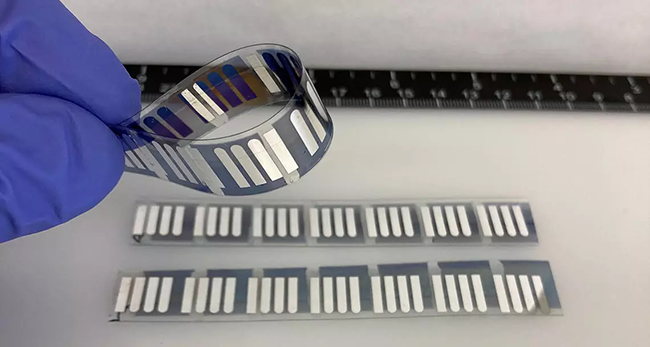Researchers continue the drive towards flexible organic semiconductors
Environment | 16-03-2022 | By Robin Mitchell
Researchers have recently made more breakthroughs in developing flexible organic solar panels that could help usher in new wearable devices. What challenges do solar panel technologies face, what did the researchers achieve, and are wearable solar panels a good idea?
What challenges do solar panels face?
Everyone can agree that fossil fuels are fundamentally flawed as their supply is limited when it comes to energy generation. While these power sources may be extremely convenient and cheap, they will eventually run out as they take millions upon millions of years to form. Furthermore, such energy sources also suffer from socio-political challenges whereby nations may be dependent on other nations for energy, and any souring relationship between the two can push energy prices unfairly high.
As such, the idea of moving towards renewable energy sources makes perfect sense from the perspective of political, social, environmental, and sustainability. Of all the renewable technologies available, the two most prominent are solar, and wind as these can easily generate electricity from readily available sources of energy found in the environment.
Solar is very popular as it works as soon as there is daylight (while windmills require the use of wind which is not consistently available), but there are some significant challenges faced with solar panels. The first is that they are costly to build due to the use of silicon wafers and the complex process needed to build them. This price tag also skyrockets when considering that solar panels are not very efficient (a good panel will get 20% if lucky). This means that large areas need to be covered with panels for any decent amount of energy generation.
The second challenge solar panels face is that their manufacture is exceptionally harmful to the environment. From the use of high-temperature crystal refinement to the use of rare materials, they require vast amounts of energy to form, which contributes to CO2 production. The use of rare materials also includes carcinogenic compounds, meaning that they can be a potential biohazard if not disposed of correctly. Thirdly, commercial panels with useable efficiencies are almost always solid in nature. While flexible panels exist, they are rarely used in portable applications as they are less efficient than solid panels while also having a lower life expectancy.
Researchers work towards commercial organic, flexible solar panels
Organic solar panels have been demonstrated by researchers many times, and some have even been made somewhat flexible. However, the biggest problem with organic solar panels is that while they do not require large amounts of energy or CO2 production, they use particularly nasty compounds that can be very harmful to living tissue. This, combined with their very low efficiencies, make them unsuitable for use with any practical application.
A team of researchers from the University of Calgary has been working on organic solar panels to create low-cost printable solar panels with commonly sourced materials. Dr Richard Pettipas and Dr Anderson Hoff have demonstrated a new method for producing such solar panels whose production process is environmentally friendly while also demonstrating the ability to create such panels over a large area.
One of the main focuses by the researchers was to use green solvents (such as ethanol), which are commonly found in the environment. This allows the researchers to source their ethanol appropriately and ensure its use and release into the environment is non-harmful. Thus, the researchers discovered methods for dissolving organic materials into the green solvents, and this mixture was then printable onto various substrates.
The result of this research was the ability to print solar cells onto a roll of substrate film that is flexible, with the resulting efficiency of the cells being as high as 11%. While this may pale in comparison to solid silicon panels whose efficiency can exceed 22%, it is a significant step in the production of viable organic flexible panels.

Flexible solar cells on a plastic substrate. Anderson Hoff and Richard Pettipas
Are wearable solar cells a good idea?
The ability to cheaply produce solar panels allows for integrating renewable energy into many applications. One application, in particular, that seems to intrigue the researchers is the use of such solar cells in wearable technology. Simply put, a comfortable solar cell that can be integrated into worn technology could power up devices without the need for a large battery. This would increase the length of operation and make the device safer (a smaller battery fails less catastrophically than a large battery).
But is the use of integrated solar panel technology such a good idea? Will future devices be able to power themselves from such a small power source? When looking at the advances made in mobile computing compared to what consumers want their devices to do, it may not be impossible to achieve. While devices such as smartphones will most definitely not be powered from organic flexible solar cells, they could be used for smaller devices such as watch devices or smart glasses. How exactly power from the cells would be transferred to the worn device is unclear, but the developments in flexible organic solar cells show real promise.

